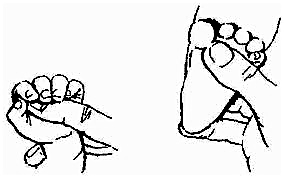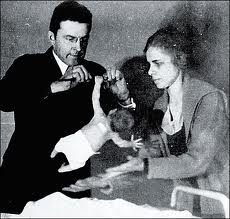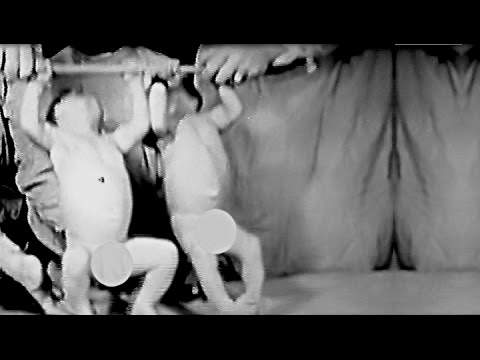Flexing of the fingers or toes when a newborn’s palm of the hand (palmar grasp) or sole (plantar grasp) of the foot is stimulated (see first figure below). The power exerted by the healthy full term newborn performing the palmar grasp (also referred to as the palmar reflex) is evident in recordings made by John B. Watson and Myrtle B. McGraw many years ago (see second and third figures below). When the palmar and plantar grasps are elicited in the newborn simultaneously, then it is possible for the infant to hang unsupported from a rope rather in the fashion of a sloth (see fourth figure below). Both grasp response can be elicited in anencephalic infants (Paulson, G., & Gottlieb, G. Developmental reflexes: the reappearance of foetal and neonatal reflexes in aged patients. Brain, 91, 37-52, 1968). Such a finding supports the contention that palmar and plantar responses in the newborn are mediate by mechanisms at the spinal level, possibly involving interneurons. Further support stems from the fact that both responses can be elicited as early as the gestational age of 25 weeks. Whether these responses and other so-called reflexes continue to have functions in human development is matter of debate, with one view treating them as phylogenetic vestiges. Both responses have clinical relevance, especially in the early detection of spasticity: athetoid cerebral palsy in the case of the palmar response and the plantar response with regard to spastic diplegia.

a. b.
Eliciting the palmar grasp (a) and plantar grasp (b) in the human newborn.


A frame grab from the film (1932) that accompanies the book by Myrtle B. McGraw Growth: a study of Johnny and Jimmy. New York: Appleton Century Crofts, 1935.

Human newborn hanging vertically (by means of the palmar grasp reflex) and upside down (by means of a simultaneous elicitation of the palmar and plantar reflexes), the latter comparing well with that of a sloth.
See Anencephaly, Athetoid (or athetotiform) movements, Cerebral palsy, Interneurons, Palmar grasp, Pincer grasp (or grip), Prehension, Reflex, Spastic diplegia, Spasticity, Spinal reflex